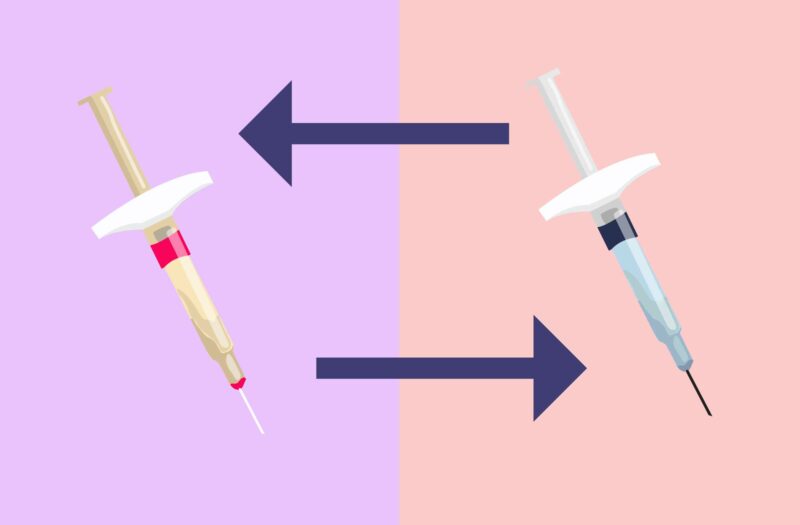Key Takeaways
- Biosimilars are highly similar versions of the biologic drugs they’re designed to mimic.
- New research review finds “switching between two biosimilars of the same reference biologic is a safe and effective clinical practice.”
- No official guidelines currently address switching between biosimilars.
Let’s face it: Medication can be really expensive, for you as well as your insurance provider (assuming you have one). That’s why many opt for generic drugs, which contain the same active ingredient as their brand-name counterparts. There may be different inactive ingredients. Biologic drugs, however, don’t come in generic form; instead, you can get a biosimilar of a brand-name biologic (reference product).
Biologic drugs are made from complex proteins, and the technology used to manufacturer them is far more complicated than what’s involved in making most other types of drugs on the market, so they can’t be replicated exactly. But biosimilars come incredibly close. Per the U.S. Food and Drug Administration (FDA), “a biosimilar is a biological product that is highly similar to and has no clinically meaningful differences from an existing FDA-approved reference product.”
If you’re thinking about taking a biosimilar, you might be wondering whether it’s just as good as the brand-name reference biologic. Rest assured that the majority of physicians who prescribe biologics say that biosimilars are equally safe and effective, according to research at NORC at the University of Chicago.
You might also be confused about whether it’s OK to switch from one biosimilar to another biosimilar of the same reference product. If you started on Humira (adalimumab), for instance, is it OK for you to take Abrilada (adalimumab-afzb, one of several biosimilars for adalimumab) one month and Hulio (adalimumab-fkjp) the next, or is it important to pick one specific biosimilar and stick with it?
Until now, there has been limited data available to help answer this question. But a new research review suggests that it’s probably fine to remain flexible and use whichever biosimilar (of the same reference product) is easiest and least expensive for you to access at a given moment.
The research, which was published in BioDrugs, was a systematic review and analysis of 23 earlier studies, 13 of which were published in peer-reviewed journals. Altogether, 3,657 patients were included in these 23 studies.
The studies were all observational, and most focused on patients switching between biosimilars of infliximab, though a few included people who switched between biosimilars of Humira (adalimumab), Enbrel (etanercept), and Rituxan (rituximab).
The authors concluded that “switching between two biosimilars of the same reference biologic is a safe and effective clinical practice … No reduction in effectiveness or increase in [adverse events] was detected in biosimilar-to-biosimilar switching studies conducted to date.”
The authors noted that the practice of switching biosimilars is not currently covered by healthy authority regulations or guidance, and that the studies that were included in their analysis have some limitations.
That said, “there is no scientific reason to expect that there would be clinically relevant differences if there are biosimilar-to-biosimilar switches,” lead author Hillel P. Cohen, PhD, told Healio Rheumatology. “The results from our review reveal that rheumatologists should have confidence that the data demonstrate that safety and effectiveness are not impacted if patients switch from one biosimilar to another biosimilar of the same reference biologic.”
What This Means for You
You should feel confident that a biosimilar of a brand-name biologic will probably work just as well for you. Switching between biosimilars of the same reference product is unlikely to cause any problems, however, it’s always best to talk about the pros and cons of switching medications with your doctor.
Breaking Down Biosimilars
Tune into Breaking Down Biosimilars, a podcast that sheds light on biosimilars and helps you better understand the role they play in your health care, now and in the future. Listen here.
If you enjoyed reading this article, you’ll love what our video has to offer.
Cohen HP, et al. Switching from One Biosimilar to Another Biosimilar of the Same Reference Biologic: A Systematic Review of Studies. BioDrugs. 2022. doi: https://doi.org/10.1007/s40259-022-00546-6.
How many biosimilars have been approved in the United States? Drugs.com. September 29, 2022. https://www.drugs.com/medical-answers/many-biosimilars-approved-united-states-3463281/.
Lu C. U.S. Pharmacist. Biosimilars: Not Simply Generics. June 18, 2019. https://www.uspharmacist.com/article/biosimilars-not-simply-generics.
Martin E, et al. Biosimilar-to-biosimilar switching safe, effective in rheumatology. Healio Rheumatology. September 22, 2022. https://www.healio.com/news/rheumatology/20220921/biosimilartobiosimilar-switching-safe-effective-in-rheumatology.
U.S. Food & Drug Administration. Generic Drugs: Questions & Answers. https://www.fda.gov/drugs/frequently-asked-questions-popular-topics/generic-drugs-questions-answers.
Wilde S, et al. NORC at the University of Chicago. Understanding Stakeholder Perception of Biosimilars. https://www.norc.org/PDFs/Biosimilars/20210405_AV%20-%20NORC%20Biosimilars%20Final%20Report.pdf.






